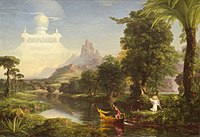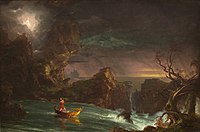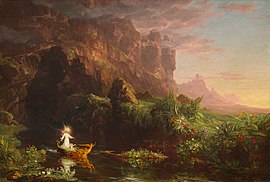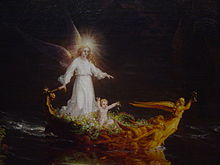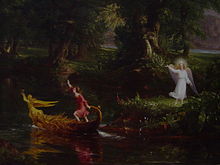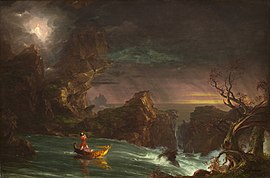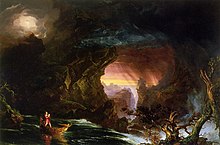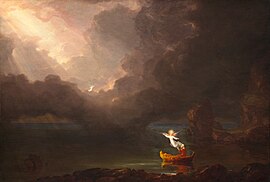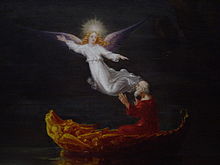
Father Time is a personification of time. In recent centuries he is usually depicted as an elderly bearded man, sometimes with wings, dressed in a robe and carrying a scythe and an hourglass or other timekeeping device.

Frederic Edwin Church was an American landscape painter born in Hartford, Connecticut. He was a central figure in the Hudson River School of American landscape painters, best known for painting large landscapes, often depicting mountains, waterfalls, and sunsets. Church's paintings put an emphasis on realistic detail, dramatic light, and panoramic views. He debuted some of his major works in single-painting exhibitions to a paying and often enthralled audience in New York City. In his prime, he was one of the most famous painters in the United States.
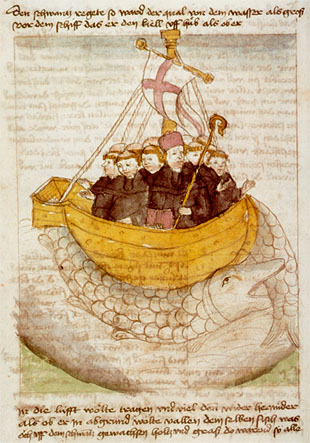
Brendan of Clonfert is one of the early Irish monastic saints and one of the Twelve Apostles of Ireland. He is also referred to as Brendan the Navigator, Brendan the Voyager, Brendan the Anchorite, and Brendan the Bold. The Irish translation of his name is Naomh Bréanainn or Naomh Breandán. He is mainly known for his legendary voyage to find the “Isle of the Blessed” which is sometimes referred to as “Saint Brendan’s Island”. The written narrative of his journey comes from the immram The Navigatio Sancti Brendani Abbatis.

The National Gallery of Art is an art museum in Washington, D.C., United States, located on the National Mall, between 3rd and 9th Streets, at Constitution Avenue NW. Open to the public and free of charge, the museum was privately established in 1937 for the American people by a joint resolution of the United States Congress. Andrew W. Mellon donated a substantial art collection and funds for construction. The core collection includes major works of art donated by Paul Mellon, Ailsa Mellon Bruce, Lessing J. Rosenwald, Samuel Henry Kress, Rush Harrison Kress, Peter Arrell Browne Widener, Joseph E. Widener, and Chester Dale. The Gallery's collection of paintings, drawings, prints, photographs, sculpture, medals, and decorative arts traces the development of Western art from the Middle Ages to the present, including the only painting by Leonardo da Vinci in the Americas and the largest mobile created by Alexander Calder.

The Hudson River School was a mid-19th-century American art movement embodied by a group of landscape painters whose aesthetic vision was influenced by Romanticism. Early on, the paintings typically depicted the Hudson River Valley and the surrounding area, including the Catskill, Adirondack, and White Mountains.

Thomas Cole was an English-born American artist and the founder of the Hudson River School art movement. Cole is widely regarded as the first significant American landscape painter. He was known for his romantic landscape and history paintings. Influenced by European painters, but with a strong American sensibility, he was prolific throughout his career and worked primarily with oil on canvas. His paintings are typically allegoric and often depict small figures or structures set against moody and evocative natural landscapes. They are usually escapist, framing the New World as a natural eden contrasting with the smog-filled cityscapes of Industrial Revolution-era Britain, in which he grew up. His works, often seen as conservative, criticize the contemporary trends of industrialism, urbanism, and westward expansion.
Manhood is a stage in life of a man.

An hourglass is a device used to measure the passage of time. It comprises two glass bulbs connected vertically by a narrow neck that allows a regulated flow of a substance from the upper bulb to the lower one due to gravity. Typically, the upper and lower bulbs are symmetric so that the hourglass will measure the same duration regardless of orientation. The specific duration of time a given hourglass measures is determined by factors including the quantity and coarseness of the particulate matter, the bulb size, and the neck width.
Events from the year 1842 in art.

The Gulf Stream is an 1899 oil painting by Winslow Homer. It shows a man in a small dismasted rudderless fishing boat struggling against the storm-tossed waves and perils of the sea, presumably near the Gulf Stream, and was the artist's statement on a theme that had interested him for more than a decade. During the time he explored this theme, Homer, a New Englander, boated often near Florida, Cuba, and the Caribbean.

View from Mount Holyoke, Northampton, Massachusetts, after a Thunderstorm, commonly known as The Oxbow, is a seminal American landscape painting by Thomas Cole, founder of the Hudson River School. The 1836 painting depicts a Romantic panorama of the Connecticut River Valley just after a thunderstorm. It has been interpreted as a confrontation between wilderness and civilization.

The Course of Empire is a series of five paintings created by the English-born American painter Thomas Cole between 1833 and 1836. It is notable in part for reflecting popular American sentiments of the times, when many saw pastoralism as the ideal phase of human civilization, fearing that empire would lead to gluttony and inevitable decay. The theme of cycles is one that Cole returned to frequently, such as in his The Voyage of Life series. The Course of Empire comprises the following works: The Course of Empire – The Savage State; The Arcadian or Pastoral State; The Consummation of Empire; Destruction; and Desolation. All the paintings are oil on canvas, and all are 39.5 inches by 63.5 inches except The Consummation of Empire which is 51″ by 76″. All five paintings are currently in the collection of the New York Historical Society.
The Piratica Series is a series of young adult fantasy novels by Tanith Lee.
The Boston Artists' Association (1841–1851) was established in Boston, Massachusetts by Washington Allston, Henry Sargent, and other painters, sculptors, and architects, in order to organize exhibitions, a school, a workspace for members, and to promote art "for the art's sake."

The Titan's Goblet is an oil painting by the English-born American landscape artist Thomas Cole. Painted in 1833, it is perhaps the most enigmatic of Cole's allegorical or imaginary landscape scenes. It is a work that "defies full explanation", according to the Metropolitan Museum of Art. The Titan's Goblet has been called a "picture within a picture" and a "landscape within a landscape": the goblet stands on conventional terrain, but its inhabitants live along its rim in a world all their own. Vegetation covers the entire brim, broken only by two tiny buildings, a Greek temple and an Italian palace. The vast waters are dotted with sailing vessels. Where the water spills upon the ground below, grass and a more rudimentary civilization spring up.

The Three Ages of Man is a painting by Titian, dated between 1512 and 1514, and now displayed at the Scottish National Gallery in Edinburgh. The 90 cm high by 151 cm wide Renaissance art work was most likely influenced by Giorgione's themes and motifs of landscapes and nude figures—Titian was known to have completed some of Giorgione's unfinished works after Giorgione died at age 33 of the plague in 1510. The painting represents the artist's conception of the life cycle. Childhood and manhood are synonymous with earthly love and death. These and the approaching old age are drawn realistically. Titian's widely chosen topic in art history, ages of man, mixed with his own allegorical interpretation make The Three Ages of Man one of Titian's most famous works.

Prometheus Bound is an 1847 oil painting by American artist Thomas Cole. Prometheus Bound is one of Cole's largest paintings, and like his other major works of the 1840s it was not the result of a commission. It draws from the ancient Greek tragedy Prometheus Bound by Aeschylus. In the painting, Prometheus is chained to a rock on Mount Caucasus in Scythia. Zeus has punished him for endowing humans with life, knowledge, and specifically for giving humans fire. Each day a raptor comes to feed on Prometheus's liver, which regrows between visits, making Zeus's punishment even more cruel.

Summer Twilight, A Recollection of a Scene in New-England is an 1834 oil-on-wood painting by British-born American painter Thomas Cole, the founder of the Hudson River School. It is currently owned by the New-York Historical Society.
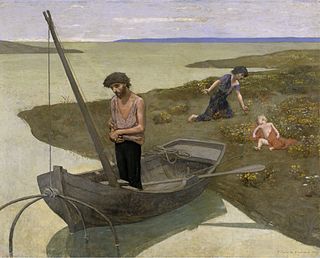
The Poor Fisherman is an oil on canvas painting by the French painter Pierre Puvis de Chavannes, created in 1879–1881. The first version is held in the Musée d'Orsay, in Paris.

